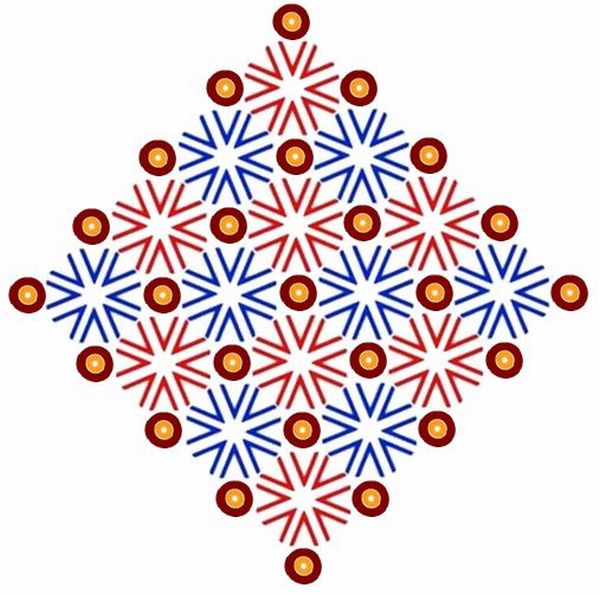vijayadaSami
The festival of nine nights or navarAtri culminates on the tenth day vijayadaSami. This is a day of victory and that is why it is called the tenth day of victory. There are three stories associated with this day. This is the day on which the paaMDavas, the sons of king pAMDu, finished their year of living incognito in the court of king virATa. arjuna, along with uttarakumAra, retrieves his weapons hidden in a Sami tree (vanni or banni) and fights the mighty kaurava army to recover the herds of cows of the king virATa stolen by them. In my opinion, the virATa parva in mahAbhArata is a "must read". This is also the day on which king rAma defeats rAvaNa to get back his beloved sItA imprisoned by the Lankan monarch. This is also the period when pArvati assails the demon mahishAsura (it is said that the name Mysore is a corrupt form of mahishUr). This is also the time when the kings in India used to raid each other for conquest. Of course, in south India, this is traditionally the time for the child to be initiated into studies. I still remember the days when we used to obtain the blessings from the elders with this SlOka -
शमी शमयते पापम् शमी शत्रुविनाशिनी । SamI SamayatE pApaM SamI SatruvinASinI
अर्जुनस्य धनुर्धारी रामस्य प्रियदर्शिनी ॥ arjunasya dhanurdhArI rAmasya priyadarSinI
The Sami leaves destroy the sins as well as the enemies as in the case of the archer arjuna and rAma to see his beloved. In fact, vijayadaSami is also split as vijayada Sami, the Sami that yields victory. Also, vijaya is another epithet for arjuna. daSarA is said to have been derived from the victory over daSyu, the evil demons.
Here is a rangOli with, what else, "V", standing for vijaya and victory. Enjoy!
Regards! - mOhana


Comments
ammuchandhini
Sun, 2010-10-17 22:20
Permalink
A very lovely pattern and so apt for vijayadasami jkm sir....d rounded designs in mustard yellow and brown look like lamps....
Lata
Mon, 2010-10-18 15:54
Permalink
Ok, I 've read this, and again. Should I ask, or, is this something I should've already known, and risk appearing completely oblivious about.
Nice rangoli depicting Victory for all, for the Indians residing in America as well :).
I got to learn about some facts thro' this post, and would like to ask about a couple of things. I had always known/read about the Pandavas as "Pandavas", or "Pandu". This is the first time I'm reading about them addressed as "Pamdavas".
The second question has to do with the transliterated version of the Sanskrit letters/shlokas. I see that words like Priyadarshini is written as Priyadarsini. What I mean is; the "sh" from the sanskrit is written as "s" in English. The pronunciation is still the same in the English version, or are we supposed to substitute the "sh" letters to "s" or "sa" letters when we say those words?
I better mention that I'm not someone who reads the scriptures at all these days. I proudly showcase my copies of Bhagavath Gita and Mahabaratha, but, unfortunately haven't found the time to open them in years. The only thing we manage to get done is we make sure our kids get to their Bal Vihar classes every Sunday morning.
jkmrao
Mon, 2010-10-18 16:47
Permalink
The answer to your questions will become obvious if you understand the transliteration schemes used. I use what is known as the RTS (Rice transliteration scheme). It is as shown below:
a A(aa) i I(ee) u U(oo) R e E(ae) ai o O(oe) au aM @h
ka kha(Ka) ga gha(Ga) ~M
ca(cha) Ca(Cha) ja jha(Ja) ~n
Ta Tha Da Dha Na
ta tha da dha na
pa pha(Pa) ba bha(Ba) ma
ya ra la va
Sa sha sa ha
You'll see that in this scheme the anusvAra (dot over the letter in dEvanAgari) is shown as M.
The correct way to write in the five groups is:
a~nga ra~njani pANDu SAnti amba
But for ease of writing, all the above are written as aMga, raMjani, pAMDu, SAMti, aMba even though the pronunciations are different.
Actually Sa (as in Siva) sha (as in bhAsha) have different sounds of pronunciation. When we say Siva, the tongue touches the lower palate and when we say bhAsha, it touches the top. Unfortunately, in the northern languages these sounds look alike even though they are written differently. Even sa is uttered as sha in beMgAli.
In ITRANS, the anusvAra is shown as .n (dot followed by n) and S is written as sh and sha is shown as Sha.
I would suggest that you try some of these using barahA whose wordpad is really really great for learning languages.
As I mentioned earlier, my familiarity with religion is more cultural. virATaparva in MB (rAjAjI's copy may be easily available) perhaps is really great to read as the story is gripping. The slaying of kIchaka by bhIma and uttarakumAra's boasting before the womenfolk are really great. There is an award winning movie acted by the late NTR called nartanaSAla (Dancing Hall) which may be available for rental or you can purchase it for less than $10 from shops wherein the story is told in a grand manner. This has some excellent songs too (including one by bAlamurali).
Regards! - mOhana
jkmrao
Mon, 2010-10-18 17:03
Permalink
Some typos -
~m not ~M, a~mga, not a~nga.
Regards! - mOhana
Lata
Mon, 2010-10-18 18:01
Permalink
Thank you very much for the clarification.